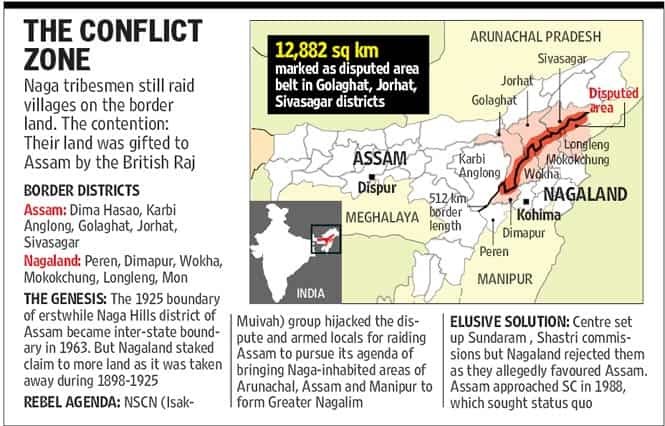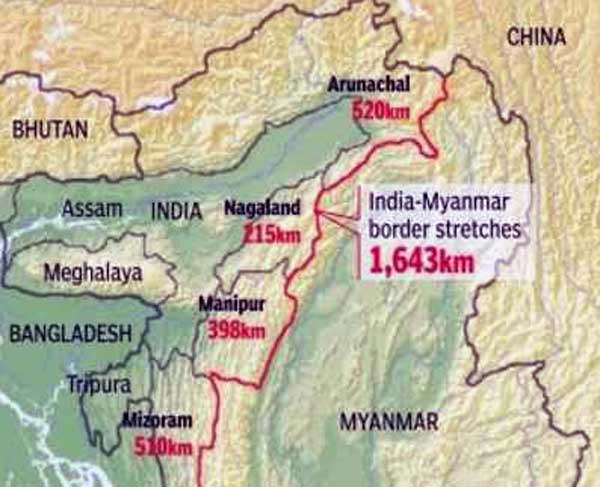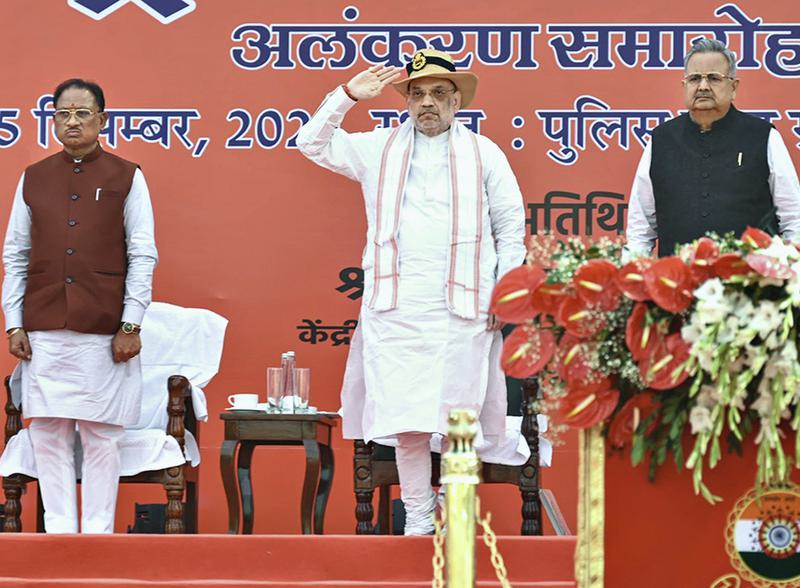Assam-Nagaland Border Dispute

- 08 Oct 2025
In News:
Tensions resurfaced along the Assam–Nagaland border after armed miscreants, allegedly from Nagaland, set fire to nearly 100 houses in a minority-dominated village within the disputed B Sector of Assam’s Golaghat district.
Background of the Dispute
- The Assam–Nagaland border dispute concerns overlapping territorial claims, particularly over forested tracts in Assam’s Golaghat, Jorhat, and Sivasagar districts, collectively known as the Disputed Area Belt (DAB).
- Since 1979, the Central Reserve Police Force (CRPF) has been deployed as a neutral force to maintain peace in these contested zones.
Historical Evolution
- Colonial Period (1826–1925):Following the Treaty of Yandabo (1826), the British annexed Assam and later established the Naga Hills District (1866). Subsequent boundary notifications redefined territories several times—often without consulting local Naga communities.
- Post-Independence Developments (1947–1963):The Nagas declared independence in 1947. Later, the Naga Hills–Tuensang Area Act (1957) and the State of Nagaland Act (1962) formalized Nagaland’s creation but did not define its boundary clearly with Assam, leaving scope for future disputes.
Commissions and Efforts at Resolution
Several commissions and agreements have attempted to resolve the dispute but failed to achieve a lasting solution:
- Sundaram Commission (1972): Led to four interim agreements maintaining the status quo.
- Shastri Commission (1985) and J.K. Pillai Commission (1997): Explored settlement options but faced rejection by one or both states.
- Variava and Chatterjee Commissions (2006): Submitted findings on boundary delineation, but implementation remained stalled.
Disputed Area Belt (DAB)
- The DAB covers forest land along the 512.1 km-long Assam–Nagaland boundary, primarily spanning Golaghat, Jorhat, Sivasagar, and KarbiAnglong districts of Assam.
- These forests were historically used by Naga tribes but fall within Assam’s constitutional limits.
Core of the Territorial Claims
- Assam’s Position:Assam upholds the constitutional boundary established when Nagaland was created in 1963, asserting that this demarcation is legally final.
- Nagaland’s Position:Nagaland bases its claim on historical and traditional Naga homelands, citing the 16-Point Agreement of 1960 and pre-colonial territorial arrangements. It seeks “restoration” of areas allegedly separated during British rule.
- Extent of Dispute:Assam accuses Nagaland of encroaching on over 60,000 hectares of land within the DAB.
Cybersecurity Threats from Southeast Asia: Rising Cyber Frauds Targeting India

- 19 Jul 2025
Introduction
Cybersecurity has emerged as a critical component of national security in the digital era. India, with its expanding digital footprint, is increasingly facing threats from transnational cybercrime syndicates. A recent analysis by the Ministry of Home Affairs (MHA) reveals a staggering Rs 1,000 crore loss per month due to cyber frauds originating from Southeast Asian countries, posing a serious threat to the Indian economy and internal security.
Magnitude of the Threat
- According to the Indian Cyber Crime Coordination Centre (I4C) under MHA: In the first five months of 2025, cyber frauds caused a total loss of around Rs 7,000 crore.
- Over 50% of the losses were attributed to networks operating from Cambodia, Myanmar, Laos, Thailand, and Vietnam.
Modus Operandi
- Fraud Centers: Operate from high-security scam compounds, primarily in Cambodia (45 identified), Laos (5), and Myanmar (1), allegedly run by Chinese operators.
- Forced Labor: Trafficked individuals, including more than 5,000 Indians, were reportedly forced to carry out cyber frauds under coercion.
- Types of Scams:
- Stock trading/investment scams
- Digital arrest scams
- Task-based/investment-based scams
Recruitment Networks and Source States
- Recruitment agents operate largely from:
- Maharashtra (59 agents)
- Tamil Nadu (51)
- Jammu & Kashmir (46)
- Uttar Pradesh (41)
- Delhi (38)
- Travel Routes Tracked:
- Routes include India to Cambodia via Dubai, China, Thailand, Vietnam, Singapore, etc.
- Cities involved include Mumbai, Chennai, Delhi, Jaipur, Lucknow, Kochi, and Kolkata.
Government Response
- Diplomatic Engagement:
- Cambodian officials met Indian authorities (MEA and Central agencies) in Delhi.
- Requested geographical coordinates of scam centers for local enforcement action.
- Inter-Ministerial Committee: Formed to identify systemic loopholes in banking, telecom, and immigration sectors.
- CBI Investigation: Registered FIRs against PoS agents involved in issuing ghost SIM cards aiding cybercrime.
Wider Implications
- Global Human Trafficking Concern: Victims from Africa, East Asia, South Asia, Central Asia, Europe, and the Americas have been found in these compounds.
- Transnational Organized Crime: The scams highlight growing cooperation between international criminal networks, using digital tools to exploit vulnerabilities across borders.
Conclusion
The scale and transnational nature of cyber frauds targeting India from Southeast Asia require a coordinated national and international response. Strengthening cyber intelligence, cross-border cooperation, digital infrastructure resilience, and public awareness are vital to securing India's cyberspace. Proactive steps such as bilateral cooperation, inter-agency coordination, and targeted enforcement are crucial to mitigate this growing internal security threat.
Maharashtra’s Special Public Security Bill, 2024
- 15 Jul 2025
In News:
The Maharashtra Special Public Security Bill, 2024, passed by the Legislative Assembly, aims to combat “urban Maoism” and left-wing extremism (LWE). Modeled on the Unlawful Activities (Prevention) Act (UAPA), the Bill introduces stringent provisions to identify and dismantle urban support networks aiding insurgents. However, it has generated significant legal and civil liberty concerns due to its vague definitions, broad executive powers, and pre-trial punitive measures.
Understanding Urban Maoism
Urban Maoism refers to the strategy of the banned CPI (Maoist) to infiltrate cities and mobilise intellectuals, students, professionals, and minorities through NGOs, protests, and media campaigns. This ideology, outlined in the 2004 document Strategies and Tactics of Indian Revolution (STIR), aims to build urban logistical support for rural armed struggles while operating under the legal guise of activism, journalism, or civil society work. Notable examples include the Elgar Parishad case (2018), where activists were arrested for alleged Maoist links following Bhima Koregaon violence.
Key Provisions of the Bill
The Bill allows the government to declare an organisation “unlawful” and penalises individuals associated with it—whether through membership, fundraising, or aiding operations. It defines “unlawful activity” as interference with public order, use of criminal force against officials, incitement to disobedience of the law, or even disrupting communication systems. Punishments range from 2 to 7 years of imprisonment along with fines. All offences are cognizable and non-bailable.
A major provision allows pre-trial forfeiture of property belonging to accused persons or organisations, with only 15 days’ notice. While the affected party can appeal to the High Court within 30 days, the initial declaration is confirmed only by an Advisory Board comprising High Court-qualified persons.
Constitutional and Legal Concerns
Civil society and legal experts argue that the Bill risks criminalising legitimate dissent and peaceful protest, given its ambiguous phrasing like “practising disobedience” or “generating apprehension in the public.” Unlike the UAPA, which requires a higher threshold for proving threat to national integrity, Maharashtra’s Bill introduces lower benchmarks that could conflate dissent with sedition.
The pre-trial forfeiture of property mirrors provisions in the Prevention of Money Laundering Act (PMLA), yet lacks equivalent safeguards like adjudication by a quasi-judicial body. Moreover, principles of natural justice, such as presumption of innocence and burden of proof on the state, appear diluted.
Broader Implications
While the state’s intent to counter urban LWE influence is valid—especially given the shift of Maoist strategies from forested hinterlands to urban centres—the means adopted pose risks to constitutional rights and federal norms. The legislation exemplifies a growing trend where extraordinary laws designed for national threats are adapted at the state level, potentially disrupting the balance between security imperatives and civil liberties.
Conclusion
The Maharashtra Special Public Security Bill reflects the complex challenge of safeguarding national security while upholding democratic freedoms. Any future enactment must incorporate judicial oversight, clearer definitions, and proportionate safeguards to ensure that the fight against extremism does not erode the fundamental rights enshrined in the Constitution.
AI-Based Warfare in the Agentic Age

- 10 Jul 2025
In News:
Artificial Intelligence (AI) is transforming the character of warfare, ushering in an era of “agentic warfare”—a paradigm where autonomous systems, not humans, are poised to dominate the battlefield. Military strategies today increasingly hinge on multi-domain operations (MDO) involving land, air, sea, cyber, and space, where decision-making speed, precision, and adaptability are crucial. AI is central to enabling this shift—but it comes with a critical caveat: energy dependency.
AI and the New Battlefield
Modern warfare relies on Big Data analytics, machine learning (ML), predictive modelling, and natural language processing (NLP)—tools that demand not only computational power but also massive energy inputs. Countries like China have already made significant strides. Its military, the People’s Liberation Army (PLA), is actively integrating AI into combat functions under the doctrine of “intelligentised warfare.” Applications range from automating artillery systems to deploying generative AI-enabled drones for radar targeting.
China’s AI developments, such as the DeepSeek model, complement battlefield deployments. Of concern to India is China’s support to Pakistan’s Centre of Artificial Intelligence and Computing (PAIC), which focuses on Cognitive Electronic Warfare. India’s Deputy Chief of Army Staff, Lt Gen Rahul Singh, revealed that Pakistan possibly used real-time Chinese satellite intelligence and AI analytics during Operation Sindoor.
India’s Response and Gaps
India was an early mover, establishing the DRDO’s Centre for Artificial Intelligence and Robotics (CAIR) in 1986 to develop AI applications for target recognition, navigation, logistics, and mine detection. However, the pace of deployment has lagged, especially compared to China. Lt Gen Amardeep Singh Aujla underlined the increasing intensity of warfare, emphasizing the necessity of C4ISR (Command, Control, Communications, Computers, Intelligence, Surveillance and Reconnaissance) and civil-military fusion to enhance readiness.
The Centre for Joint Warfare Studies (CENJOWS) notes the growing global use of AI in weapon systems, battlefield simulation, and cyber defence. For instance, Ukraine’s AI-powered drones have autonomously struck Russian oil facilities. Israel’s “Lavender” AI system has reportedly identified over 37,000 Hamas targets, exemplifying the real-time integration of AI in warfare.
Energy: The Hidden Backbone
While AI’s capabilities are evident, its energy appetite is equally significant. AI infrastructure—data centres, servers, and cooling systems—requires vast amounts of electricity, often from stable sources like nuclear energy. India’s current installed nuclear capacity (~7.5 GW) is starkly inadequate when compared to countries like South Korea (over 22 GW), limiting India's long-term AI defence potential.
Kris P. Singh, CEO of Holtec International, argues that Small Modular Reactors (SMRs) placed near AI data hubs could be the solution. He proposes co-locating SMRs with military or strategic data centres to power next-generation capabilities like drones, smart soldiers, and robotics. India's past policy to limit thermal power and insufficient storage in renewable energy has created grid instability, further compounding the challenge.
Way Forward
To remain strategically relevant, India must:
- Accelerate AI adoption in defence through institutional synergy and private sector participation.
- Invest in energy infrastructure, particularly clean, stable sources like SMRs.
- Promote indigenous AI R&D, focusing on secure, sovereign data ecosystems.
- Establish MDO doctrines incorporating AI, space, and cyber capabilities.
In the agentic age, the nation that combines AI mastery with robust energy capacity will define the future of warfare. India’s security strategy must urgently align with this reality.
Rising Participation and Casualties of Women in Left-Wing Extremism
- 27 Jun 2025
Context:
There has been a sharp surge in the number of women Maoist cadres killed in anti-Naxal operations in Chhattisgarh since 2024. This rise has coincided with the intensification of counter-insurgency efforts under the Ministry of Home Affairs’ (MHA’s) renewed push to eliminate Left-Wing Extremism (LWE) by March 2026.
Behind these numbers lies a disturbing narrative of coercion, indoctrination, gender-based exploitation, and the systemic use of women and children as tools in extremist strategies.
Trends in Women Maoist Casualties (2024–2025)
- 2024: Out of 217 Maoists killed, 74 were women (~34%)
- 2025 (till June 20): Out of 195 killed, 82 were women (~42%)
- Comparison with previous years:
- 2019: 65 total killed | 17 women
- 2020: 40 total | 7 women
- 2021: 51 total | 13 women
- 2022: 30 total | 9 women
- 2023: 20 total | 5 women
This data indicates a doubling of women fatalities as a proportion of total casualties in Maoist operations since the launch of targeted operations.
Recruitment Through Coercion: Bal Dastas and Gendered Exploitation
According to the MHA, Maoists have been increasingly recruiting young Adivasi girls and forming “Bal Dastas” (child squads) in Chhattisgarh and Jharkhand. Key observations include:
- Parental coercion: Many impoverished tribal families are forced to give up their girl children under threats and pressure.
- Ideological indoctrination: Children are brainwashed to adopt Maoist ideology from an early age.
- Gendered exploitation: Although the Maoists outwardly reject patriarchy, the representation of women in leadership roles such as the Polit Bureau and Central Committee remains negligible.
- Use of women as foot soldiers and human shields, exposing them disproportionately to fatal encounters with security forces.
Underlying Issues: Security, Society, and Maoist Strategy
- Deliberate Alienation Strategy:
- Maoists systematically attack schools and educational infrastructure.
- As per MHA, education fosters critical thinking and alternate livelihoods, which are seen as a threat to Maoist influence.
- Civilian and Infrastructure Loss:
- Since 2019:
- 725 civilians killed in LWE violence.
- 263 incidents of attacks on economic infrastructure recorded.
- Since 2019:
- Socio-Economic Backdrop:
- Lack of education, healthcare, livelihood options, and state presence in remote tribal areas fuel Maoist recruitment.
- Women and children from these regions become the most vulnerable and easily exploited demographic.
Security Forces' Perspective and Response
- Initial recruitment of women was largely based on coercion and misinformation.
- Once inside the Maoist ranks, women face physical, mental, and emotional exploitation.
- Maoists use women primarily as human shields and expendable foot soldiers.
However, the security forces are increasingly pursuing a sensitive, gender-aware approach, prioritizing:
- Voluntary surrender schemes
- Gender-sensitive rehabilitation policies offering:
- Education
- Vocational training
- Healthcare access
- Social reintegration pathways
Way Forward: A Multi-Pronged Strategy
- Strengthen Surrender and Rehabilitation Frameworks:
- Expand socio-economic reintegration schemes tailored for women ex-cadres.
- Ensure psycho-social counselling, particularly for minors and survivors of exploitation.
- Enhance State Presence and Welfare Delivery:
- Accelerate development of infrastructure, education, and healthcare in LWE-affected districts.
- Promote community policing and tribal leadership in governance processes.
- Child Protection Measures:
- Strengthen child protection systems, including monitoring of Bal Dastas.
- Empower and engage Anganwadi workers, school teachers, and local NGOs in vulnerable zones.
- Gender-Sensitive Counter-Insurgency Doctrine:Train forces in humane engagement, protection of rights, and de-escalation tactics when dealing with women and child cadres.
Operation Sindoor and the Emerging Imperative of Digital Warfare in India’s National Security

- 12 May 2025
In News:
On May 7, India launched Operation Sindoor, targeting terrorist bases in Pakistan in response to the Pahalgam terrorist attack on April 22. This military action quickly became a case study in how modern warfare extends beyond physical battlegrounds to include digital and information domains.
Managing Information During Conflict
Following the operation, India’s Ministry of Defence issued an advisory on May 9 urging media, digital platforms, and individuals to avoid live or real-time reporting of military movements. The Press Information Bureau (PIB) also stressed sharing only official updates to counter the spread of misinformation. This advisory was crucial after fake news, including false claims that the INS Vikrant aircraft carrier attacked Pakistani ports, spread rapidly on social media and TV channels. The misinformation originated from a fraudulent social media account pretending to be the INS Vikrant, causing panic and confusion, which was then amplified by Pakistani sources.
Hybrid Nature of Modern Conflicts
Modern conflicts have evolved into “hybrid wars” that combine traditional military operations with sophisticated information warfare. Research from King’s College London highlights how states use both traditional and social media platforms for “perception management”—influencing public opinion to strengthen domestic support or destabilise opponents. In such environments, misinformation spreads rapidly due to media pressure to break news first, public anxiety seeking instant updates, and social media algorithms that prioritise sensational content regardless of accuracy.
Cyber Warfare: The Invisible Battlefield
Digital warfare also includes cyberattacks on critical infrastructure and military networks. Since the Pahalgam attack, India has faced several cyber intrusions originating from Pakistani and spoofed networks. Cyber operations now run parallel to physical conflicts, forming a multi-domain battlespace where controlling information flow and disrupting enemy networks are as vital as territorial gains.
Recent global examples include Russia’s cyberattacks on Ukraine during the 2022 invasion and retaliatory cyber operations by Ukrainian hackers. Similarly, after Hamas’s October 2023 attack, Israel faced massive cyber assaults and widespread disinformation campaigns on social media using AI-generated content.
Challenges in Cyber Conflict
Cyber warfare is especially challenging because attacks are remote, anonymous, and difficult to attribute. Attackers hide behind proxies and compromised systems, complicating diplomatic responses and exposing gaps in international laws governing cyber conflicts. As tensions rise, India may encounter more frequent and sophisticated cyberattacks targeting its infrastructure, military communications, and financial systems, alongside conventional military threats.
India’s Preparedness Strategy
To tackle these challenges, India must adopt a comprehensive strategy combining legal, diplomatic, and technological measures:
- Legal: Strengthen cybersecurity laws under the Information Technology Act and push for international agreements to regulate state-sponsored cyberattacks.
- Diplomatic: Enhance cooperation in global forums like the UN Group of Governmental Experts (GGE) and partner with technologically advanced nations to identify and counter hostile cyber activities.
- Technological: Invest heavily in cyber defence and offence capabilities. Critical infrastructure must be fortified through security audits, network segmentation, and resilient backups. Agencies such as the National Critical Information Infrastructure Protection Centre (NCIIPC) and CERT-In need enhanced capacities to detect and respond to threats. Regulators should promote continuous network monitoring and public awareness on cybersecurity, exemplified by the Reserve Bank of India’s directives to banks.
Conclusion
The digital battlefield—comprising misinformation and cyberattacks—demands a coordinated government response and active citizen engagement. As conventional and digital warfare increasingly overlap, India’s national security depends on not only military preparedness but also information resilience and cybersecurity. With well-planned, multi-dimensional strategies, India can effectively confront emerging digital threats and secure its sovereignty in an increasingly complex geopolitical environment.
India’s Coastal Crisis
- 31 Mar 2025
In News:
India’s vast coastline, stretching over 7,500 kilometres across nine states and four Union Territories, is a crucial ecological and economic asset. It supports diverse marine ecosystems, sustains the livelihoods of approximately 16 million fishers, and contributes around 4% to the national GDP through fisheries, tourism, and shipping activities. However, India’s coastal regions face a growing crisis from two interconnected challenges: rampant illegal light fishing and accelerating coastal erosion.
Illegal Light Fishing: Ecological and Socioeconomic Impacts
Light fishing, a method that employs high-powered artificial lights to attract fish and squid to the surface at night, is officially banned in India’s Exclusive Economic Zone (EEZ) since 2017. Despite this, enforcement remains weak and patchy, particularly within territorial waters of Maharashtra, Tamil Nadu, Andhra Pradesh, and Kerala. Mechanized boats equipped with powerful LED lights continue this practice, causing severe ecological disruption and threatening traditional fishing communities.
High-intensity lights lure not only adult fish but also juveniles and non-target species (bycatch), resulting in overfishing and depletion of juvenile stocks. This has been linked to coral reef degradation and altered marine food webs, especially impacting slow-moving species like squid, which are vital to the coastal ecosystem. Studies by institutions like the Central Marine Fisheries Research Institute have highlighted how light fishing disrupts spawning cycles and jeopardizes fish recruitment during critical periods.
Socially, light fishing disadvantages artisanal fishers who rely on traditional methods and smaller boats. The National Fishworkers Forum has documented declining catches and conflicts between small-scale fishers and mechanized operators. Moreover, the economic incentives for illegal light fishing are high, as single trips can yield profits exceeding ?1 lakh, whereas penalties, such as fines of ?16,000, are insufficient deterrents.
Coastal Erosion: Increasing Vulnerability and Habitat Loss
Alongside overfishing, India’s coastline is increasingly vulnerable to erosion, exacerbated by rising sea levels (currently about 3.2 mm per year), frequent cyclones, and human activities such as sand mining and unregulated coastal development. Recent government data indicates that 33.6% of India’s coastline is affected by erosion, with places like Dakshina Kannada in Karnataka losing nearly half of their shoreline over three decades.
Coastal ecosystems such as mangroves and coral reefs serve as natural buffers against wave action, reduce erosion, and play a critical role in carbon sequestration. For instance, the Bhitarkanika mangroves in Odisha absorb four times more carbon than terrestrial forests, helping mitigate climate change. However, urban expansion and infrastructure projects have led to significant mangrove loss—Mumbai has lost 40% since 1987—reducing the coastline’s resilience against natural disasters.
Pollution from plastic waste and industrial effluents further degrades marine habitats, while weak enforcement of Coastal Regulation Zone (CRZ) norms allows illegal constructions that exacerbate ecological damage.
Way Forward: Policy, Enforcement, and Community Engagement
Addressing India’s coastal crisis requires a multi-pronged approach:
- Strengthening Enforcement: There is an urgent need for uniform nationwide enforcement of the light fishing ban, enhanced patrolling using technologies like AI-enabled drones, and more stringent penalties to deter violations.
- Ecological Restoration: Initiatives such as artificial reefs, mangrove afforestation, and sand replenishment can restore natural coastal buffers. Programs like those in Puducherry and Odisha demonstrate the effectiveness of such measures.
- Community Participation: Empowering fisherfolk through capacity-building and involving local communities in surveillance and sustainable fishing practices is critical. Tamil Nadu’s fisher unions serve as a successful model of local stewardship.
- Climate Adaptation and Research: Relocating vulnerable settlements, investing in cyclone-resistant infrastructure, and expanding scientific research, such as satellite monitoring of erosion hotspots, are essential for long-term resilience.
Conclusion
India’s coastal regions are at a crossroads, balancing economic development, ecological sustainability, and social equity. Illegal light fishing and coastal erosion threaten marine biodiversity and the traditional livelihoods of millions. Effective governance, backed by technological innovation and community collaboration, is indispensable to safeguard India’s maritime heritage and ensure sustainable use of coastal resources in alignment with Sustainable Development Goal 14.
India’s Counter-Naxal Strategy
- 24 Mar 2025
In News:
The Government of India, has adopted a zero-tolerance policy against Left-Wing Extremism (LWE), commonly referred to as Naxalism. The Central Government has set a target to make India Naxal-free by March 2026, a goal backed by integrated security, developmental, and governance strategies.
Current Status and Achievements
Recent operations in Chhattisgarh’s Bijapur and Kanker districts led to the neutralization of 22 Naxalites, highlighting the success of the ongoing ‘Naxalmukt Bharat Abhiyan’. In 2025 alone, 90 Naxalites were killed, 104 arrested, and 164 surrendered. In 2024, these figures stood at 290 neutralized, 1,090 arrested, and 881 surrendered. Additionally, 15 top Naxal leaders have been eliminated.
There has been a 53% decline in Naxal-related incidents, from 16,463 cases (2004–14) to 7,744 (2014–24). Casualties among security forces have dropped by 73%, and civilian deaths by 70% in the same period. Fortified police stations increased from 66 (2014) to 612 (2024). The number of Naxal-affected districts has drastically reduced from 126 to 12, indicating a marked shrinkage in the Red Corridor.
India’s Multi-Pronged Approach
The National Policy and Action Plan to Address LWE (2015) guides the Centre’s counter-Naxal efforts through three pillars: security enhancement, development outreach, and ensuring rights and entitlements.
- Security Operations:
- Major operations like Operation Green Hunt deploy Central Armed Police Forces (CAPFs), CoBRA commandos, and state-level forces like Greyhounds (Andhra Pradesh).
- 302 new security camps and 68 night landing helipads have been established in vulnerable regions for better mobility and reach.
- Development Initiatives:
- Under PMGSY-II, the Road Connectivity Project for LWE Areas improves access to remote villages.
- 130 Eklavya Model Residential Schools (EMRS) ensure tribal children receive quality education.
- The ROSHNI Scheme and establishment of Industrial Training Institutes (ITIs) provide skill development and livelihood avenues to tribal youth.
- The Universal Service Obligation Fund (now Digital Bharat Nidhi) has led to widespread mobile tower installation in forested areas.
- Tribal Youth Exchange Programs promote national integration and awareness among tribal youth.
- Legal and Institutional Measures:
- The Unlawful Activities (Prevention) Act, 1967 (UAPA) bans CPI (Maoist) and affiliated organizations.
- Forest Rights Act (2006) and PESA (1996) aim to protect tribal land and forest rights.
- Surrender-cum-Rehabilitation policies provide financial aid, vocational training, and reintegration support.
Understanding Naxalism
Naxalism, rooted in the 1967 uprising in Naxalbari (West Bengal), is a Maoist-inspired insurgency seeking to overthrow the Indian state through armed rebellion. Factors contributing to its rise include landlessness, tribal alienation, poverty, displacement from mining and industrial projects, and state neglect. The insurgency remains concentrated in the “Red Corridor” encompassing Chhattisgarh, Jharkhand, Odisha, Maharashtra, and Bihar.
Conclusion
India’s counter-Naxal policy demonstrates that a balanced approach combining firm security enforcement with development and governance reforms can significantly curb insurgency. Continued emphasis on inclusive growth and tribal empowerment remains crucial to achieving lasting peace in affected regions.
Free Movement Regime

- 27 Dec 2024
In News:
The Indian government, through the Ministry of Home Affairs (MHA), has recently issued new guidelines to regulate the movement of people between India and Myanmar, especially along the border regions. These guidelines come after the suspension of the Free Movement Regime (FMR), which had previously allowed residents within a specified range of the border to move freely. The new protocol aims to enhance internal security and address concerns related to demographic shifts in India's northeastern states.
Background of the Free Movement Regime (FMR)
What is FMR?
The Free Movement Regime (FMR) is a bilateral arrangement between India and Myanmar that permits residents living in border areas to cross the international boundary without a visa. This agreement was established in 1968 to facilitate familial, cultural, and economic exchanges between people living on either side of the border.
Territorial Limits and Evolution
Initially, the FMR allowed free movement within a 40 km radius from the border. However, in 2004, this limit was reduced to 16 km, and additional regulations were introduced in 2016. The most recent development sees the limit further reduced to 10 km, with stricter regulations implemented to regulate the movement.
Recent Developments and New Guidelines
Suspension of FMR
In February 2023, Union Home Minister Amit Shah announced the suspension of the FMR along the India-Myanmar border, citing concerns about internal security and demographic changes, particularly in India's northeastern states. This decision came in the context of growing ethnic violence and political pressures, especially from states like Manipur.
Despite the announcement, the formal scrapping of the FMR is yet to be officially notified by the Ministry of External Affairs (MEA). However, the MHA has issued new guidelines to regulate cross-border movement, focusing on enhancing security without completely discontinuing the regime.
Key Features of the New Guidelines
The updated protocols issued by the MHA include several measures aimed at improving the security and regulation of movement across the border:
- Reduced Movement Limit: The new guidelines reduce the free movement limit from 16 km to 10 km from the border on both sides.
- Border Pass System: Residents wishing to cross into Myanmar or return to India must obtain a "border pass" from the Assam Rifles. This pass allows a stay of up to seven days in the neighboring country.
- Document and Health Checks: Upon entry into India, individuals will undergo a document inspection by the Assam Rifles, followed by security and health checks conducted by state police and health authorities. Biometrics and photographs will be collected, and a QR code-enabled border pass will be issued for verification.
- Designated Entry Points: There will be 43 designated entry and exit points across the border, with biometric verification and health screening required at all points.
- Monitoring and Enforcement: The Assam Rifles will oversee the movement, ensuring that individuals comply with the new regulations. Violations of the movement protocol will result in legal action.
Infrastructure and Technology Implementation
The government plans to establish infrastructure, such as biometric machines and software for border pass issuance. Pilot entry and exit points will be operational soon, with a phased implementation for the remaining points.
Political Reactions and Opposition
Regional Concerns and Opposition
The suspension of the FMR has been a contentious issue in India's northeastern states. The governments of Nagaland and Mizoram have raised objections to the scrapping of the regime, citing the cultural and familial ties of border communities. The Nagaland Assembly passed a resolution opposing the government's decision, while political leaders in Manipur argued that the unregulated movement of people had contributed to ethnic violence in the region.
Specific Concerns in Manipur
The chief minister of Manipur, N. Biren Singh, attributed ongoing ethnic conflicts in the state to the unchecked movement of people across the border. This was particularly evident in the violent ethnic clashes that broke out in 2023. As a result, Singh urged the Home Ministry to cancel the FMR along the India-Myanmar border, and the new guidelines reflect the state's concerns.
Conclusion
The suspension of the Free Movement Regime along the India-Myanmar border, followed by the introduction of stricter guidelines, marks a significant shift in India's border management policy. While the formal scrapping of FMR is yet to occur, the new protocols aim to balance security concerns with the region's long-standing cultural ties. The implementation of biometric checks and designated entry points signifies the government’s focus on modernizing border control while addressing regional concerns. The outcome of this policy shift will have important implications for internal security, demographic dynamics, and bilateral relations between India and Myanmar.
Commitment to Eradicating Naxalism in Chhattisgarh by 2026

- 17 Dec 2024
Overview
Union Home Minister Amit Shah has reiterated India's commitment to eliminate Naxalism in Chhattisgarh by March 31, 2026. He emphasized the progress made in the fight against Naxalism, highlighting key successes and outlining the strategy for the coming years.
Key Pointers
- Government Commitment: Amit Shah emphasized the joint commitment of the Government of India and the Chhattisgarh state leadership to rid the state of Naxalism by 2026.
- Security Forces’ Success: Over the past year, Chhattisgarh police neutralized 287 Naxalites, arrested around 1,000, and saw 837 surrenders.
- Top Naxal Cadres Neutralized: The state forces successfully neutralized 14 high-ranking Naxal cadres.
- President’s Police Colour Award: Chhattisgarh Police received the President's insignia within 25 years, a significant achievement for the state.
The Three-Pronged Strategy for Eliminating Maoist Insurgency
- Security Measures (Force)
Deployment of Security Forces
- Enhanced Presence: Increased deployment of Central and State police forces in Left-Wing Extremism (LWE) areas.
- Joint Operations: Coordinated operations between state and central forces, including CRPF and COBRA units.
- Upgraded Technology: Incorporation of UAVs, solar lights, and mobile towers to enhance operational efficiency.
Operation SAMADHAN
- Key Elements:
- Smart Leadership: Leading with innovative strategies.
- Aggressive Strategy: Swift, decisive action against insurgents.
- Motivation and Training: Strengthening the capabilities of forces.
- Actionable Intelligence: Real-time intelligence for effective operations.
- Harnessing Technology: Using modern tech for strategic advantage.
2. Development Initiatives
Focused Development Schemes
- PMGSY: Rural road connectivity under the Pradhan Mantri Gram Sadak Yojana.
- Aspirational Districts Program: Improving infrastructure in Naxal-affected areas.
- Skill Development: Targeted schemes in 47 LWE-affected districts to reduce unemployment.
Infrastructure Development
- Special Infrastructure Schemes: Building schools, roads, and bridges in remote areas to integrate them into the mainstream economy.
- Rehabilitation: Focus on providing rehabilitation for former Naxals through education and vocational training.
3. Empowerment (Winning Hearts and Minds)
Public Engagement
- Tribal Empowerment: Strengthening communication with tribal communities to reduce alienation and mistrust.
- Rehabilitation Policies: Surrender schemes offering incentives like education and financial aid to reintegrate former insurgents into society.
Maoism: Ideology and Background
What is Maoism?
- Origin: A form of communism developed by Mao Tse Tung, focusing on armed insurgency to capture state power.
- Core Beliefs: Maoists believe in violence and insurrection as legitimate means to overthrow the state and establish a People’s Democratic Republic.
- Indian Maoism: The Communist Party of India (Maoist), formed in 2004, leads the largest Maoist insurgency in India.
Recent Achievements in Combatting Maoist Insurgency
Key Successes in 2023
- Maoist-Free Villages: Villages in Dantewada declared "Maoist-free," a significant victory for the state.
- Reduction in Security Forces’ Casualties: 14 deaths in 2024, a dramatic decrease from 198 deaths in 2007.
- Infrastructure and Logistical Support: Enhanced use of helicopters and fortified police stations.
Government’s Commitment to Rebuilding
- Rehabilitation and Welfare: The government is implementing policies to improve the living standards of affected families, including 15,000 houses for Naxal-affected regions.
- Economic Development: Focus on building infrastructure and providing employment through skills training programs.
Challenges in Eliminating Naxalism
Socio-Economic Issues
- Exploitation of Tribals: Marginalization of tribals due to displacement for mining and forestry.
- Lack of Infrastructure: Basic amenities like roads, schools, and healthcare are absent in many areas.
- Centralized Naxal Command: The CPI (Maoist) retains a strong leadership, despite fragmentation of its forces.
Governance and Trust Issues
- Alienation of Local Populations: Ineffective governance and poor implementation of welfare schemes fuel local support for Naxal groups.
- Resource Conflict: The Naxals exploit rich mineral resources in the region to fund their insurgency.
Way Forward
Governance and Economic Reforms
- Tribal Empowerment: Form Tribal Advisory Councils as per the Fifth Schedule for better resource management.
- Land Redistribution: Enforce the Land Ceiling Act to reduce inequality.
- Livelihood Programs: Offer alternative livelihoods to reduce dependency on illegal activities.
Security Measures
- Paramilitary Deployment: Specialized forces to secure tribal areas and enable local governance.
- Resource Management: Ensure sustainable exploitation of natural resources, involving tribal communities in the decision-making process.
Peace Dialogues
- Inclusive Policies: Engage in dialogue with Naxals to facilitate their reintegration into mainstream society.
Conclusion
Naxalism in India, particularly in Chhattisgarh, is a complex issue rooted in socio-economic inequalities, lack of development, and historical alienation of tribal communities. The government's approach, encapsulated in the SAMADHAN strategy, combines security operations with developmental initiatives and a focus on empowerment to tackle the problem. With a clear commitment to eliminate Naxalism by 2026, the Indian government is making significant strides in reducing violence, improving governance, and integrating affected communities into the mainstream.
Beware of Digital Wedding Invites

- 08 Dec 2024
In News:
In the peak wedding season, cyber fraudsters are increasingly exploiting digital wedding invitations to hack into mobile phones. These fraudulent invites, often disguised as PDF wedding cards shared on WhatsApp, contain embedded malware that allows cybercriminals to gain full access to the victim's phone. This includes access to sensitive financial data, making individuals vulnerable to fraud. The Lucknow Police Cyber Cell has issued a public warning, urging citizens to be cautious and avoid opening suspicious files.
How the Scam Works
The scam involves cybercriminals sending out malware-laden wedding invitations. Once the recipient opens the file, the malware infects their phone, enabling the fraudsters to remotely control the device. From there, they can access sensitive information, including bank account details, and may even transfer funds without the victim’s consent.
Preventive Measures and Cyber Hygiene
To protect against such scams, individuals should follow these preventive steps:
- Avoid Suspicious Files: Do not open files from unknown senders, particularly those with extensions like APK, PIF, or VBS. It is crucial to verify the sender's number—legitimate Indian numbers typically begin with +91.
- Turn Off Auto-Download: Disabling automatic downloads on platforms like WhatsApp can prevent files from being opened unknowingly.
- Enable Two-Step Verification: Strengthen security by activating two-step verification on your digital accounts and setting strong passwords.
- Report Fraud Immediately: In case of suspicious activity, contact the cybercrime helpline at 1930 or file a complaint on the official cybercrime portal (www.cybercrime.gov.in).
The Lucknow Police’s “Cyber Pathshala” campaign aims to raise awareness and educate the public on digital scams, particularly during the wedding season when these frauds are at their peak.
Cybersecurity Challenges in India
This emerging digital threat is part of a broader trend of sophisticated cybercrimes in India. Cyber fraudsters are increasingly using manipulative tactics, such as phishing, fake digital arrests, and malware attacks. In 2024, India witnessed a significant rise in ransomware attacks, frauds targeting financial institutions, and supply chain vulnerabilities.
India's legislative and institutional frameworks are evolving to address these challenges. Key measures include:
- The Information Technology Act, 2000, which lays the foundation for tackling cybercrimes.
- The Digital Personal Data Protection Act, 2023, which focuses on protecting personal data.
- The Indian Computer Emergency Response Team (CERT-In), which coordinates national responses to cyber incidents.
Additionally, new frameworks like the National Cyber Security Policy, 2013, and initiatives such as Cyber Surakshit Bharat and the Indian Cyber Crime Coordination Centre (I4C), aim to fortify India's digital landscape and promote cybersecurity.
Emerging Cyber Threats
As India becomes more digitally connected, the threat landscape continues to evolve:
- Digital Arrest Scams: Fraudsters impersonate law enforcement to extort money from victims, claiming they are under investigation for fictitious crimes.
- Ransomware: Attacks on critical infrastructure, such as financial institutions and healthcare systems, have led to operational disruptions and financial losses.
- Deepfake Technology: The rise of AI-generated deepfakes poses significant risks, including misinformation and financial fraud.
- Internet of Things (IoT) Vulnerabilities: The rapid adoption of IoT devices has created new security challenges, with many devices lacking adequate protection.
Strategic Recommendations for Enhancing Cybersecurity
To counter these evolving threats, India must focus on several strategic areas:
- Digital Literacy Campaigns: Nationwide efforts to improve digital literacy, particularly targeting vulnerable groups such as rural populations and senior citizens.
- Stronger IoT Security Protocols: Mandating secure design and certification for IoT devices.
- AI-Driven Threat Intelligence: Implementing AI-based tools for early threat detection and response in critical sectors.
- Mandatory Cybersecurity Audits: Regular audits of critical infrastructure, especially in sectors like healthcare, banking, and utilities.
- Public-Private Collaboration: Strengthening partnerships to address challenges such as cryptocurrency fraud, ransomware, and dark web-enabled crimes.
Conclusion
The rise of digital fraud, including the manipulation of wedding invitations for malicious purposes, highlights the need for enhanced cybersecurity measures in India. By improving public awareness, investing in technological solutions, and reinforcing legal and institutional frameworks, India can better protect its citizens from the growing threat of cybercrime. A proactive and informed approach is essential to secure the digital future of the nation.
Current Representation of Women in CAPFs

- 04 Dec 2024
In News:
The Central Armed Police Forces (CAPFs) of India, comprising forces like CRPF, BSF, CISF, and others, play a crucial role in maintaining internal security. Women’s participation in these forces has been historically limited, but recent efforts have focused on increasing their representation. As of 2024, women constitute only 4.4% of the total personnel in CAPFs, highlighting the slow progress despite various initiatives.
Current Representation and Changes Over Time
- Overall Representation: Women make up 4.4% of the 9.48 lakh-strong CAPFs. Within this, the Central Industrial Security Force (CISF) has the highest representation at 7.02%, followed by the Sashastra Seema Bal (SSB) at 4.43%, Border Security Force (BSF) at 4.41%, Indo-Tibetan Border Police (ITBP) at 4.05%, Assam Rifles at 4.01%, and Central Reserve Police Force (CRPF) at 3.38%.
- Growth of Women Personnel: From 15,499 women in 2014, the number has tripled to 42,190 in 2024, reflecting a steady increase in recruitment. However, the percentage remains low despite these gains.
- Recruitment Trends: In 2024, 835 women were recruited, with 5,469 more in the process. In 2025, 4,138 women are expected to be recruited.
Government Efforts and Parliamentary Committee Recommendations
- Policy Measures: The government has introduced several steps to encourage women’s participation in CAPFs, such as reservations in constable-level positions: one-third for CRPF and CISF, and 14-15% for border forces like BSF, SSB, and ITBP.
- Challenges in Recruitment: Despite these policies, recruitment has not kept pace with the targets. The 2022 Parliamentary Committee on Home Affairs expressed disappointment over the “abysmally low” number of women in CAPFs, noting that women made up only 3.68% of the forces at that time.
- Recommendations by Parliamentary Committees:
- The Home Affairs Committee recommended fast-tracking phase-wise recruitment of women, particularly in CISF and CRPF.
- The Standing Committee on Personnel (2023) suggested “soft postings” for women to avoid difficult working conditions, especially in remote or strenuous terrains. It also called for reservations for transgender individuals.
- In 2024, further steps like fee waivers, relaxed physical standards, and provisions for maternity and child care leave were introduced to make the work environment more inclusive.
Reasons Behind Low Representation
- Cultural Barriers: Traditional gender roles and societal expectations deter many women from pursuing careers in security forces.
- Work Environment: The demanding nature of the job, which includes postings in remote areas and high-risk operations, makes it less appealing, especially for women with family responsibilities.
- Infrastructure Issues: Lack of adequate accommodation, sanitation facilities, and safety measures for women are deterrents to joining and retaining female personnel.
Conclusion and Future Outlook
Although the representation of women in CAPFs has seen improvement, it remains below expectations due to persistent challenges. The government’s continuous focus on recruitment reforms, better working conditions, and policy incentives will be crucial to achieve gender parity in these forces. As societal attitudes evolve and the infrastructure improves, more women may be encouraged to serve in these vital security roles. Future efforts must include targeted recruitment drives and creating a more inclusive and supportive environment to enhance women’s participation in CAPFs.
Digital Arrests

- 01 Dec 2024
In News:
In 2024, India has witnessed an alarming rise in cybercrime, particularly a new scam called "digital arrests." This type of fraud involves criminals impersonating law enforcement officials to extort money from victims. With more than 92,000 people targeted and ?2,141 crore defrauded from victims, these scams are rapidly becoming a significant concern for the public and law enforcement.
Nature of ‘Digital Arrests’
The modus operandi of digital arrest scams is sophisticated and emotionally manipulative. Cybercriminals contact victims through video calls, often using fake police officers' profiles and official documents to build credibility. They accuse victims of serious crimes such as money laundering or drug trafficking, claiming urgent action is needed to avoid arrest. The scammers create a false atmosphere of fear and urgency, convincing the victim to transfer large sums of money under the pretext of settling legal dues.
A notable example involves Ruchi Garg, who was targeted by scammers posing as police officers, falsely claiming her son was involved in a major scam. She was coerced into transferring ?80,000 before realizing it was a scam. Similar cases have affected hundreds, with perpetrators using AI-generated voices and fake visuals to amplify the deception.
The Growth of Cybercrime in India
Digital arrest scams are part of a broader increase in cybercrime in India. The Indian Cyber Crime Coordination Centre (I4C) has reported a rise in cyber fraud, with financial losses exceeding ?27,900 crore between 2021 and 2024. The most significant sources of these losses include stock trading scams, Ponzi schemes, and digital arrest frauds. As criminals adapt to emerging technologies and use social engineering tactics, the scale and complexity of scams are growing.
The surge in cybercrimes is fueled by vulnerabilities in India's digital landscape. With over 95 crore Internet users, many people, particularly the elderly or less tech-savvy, remain susceptible to such fraud. Cybercriminals often exploit this lack of awareness, combining fear and confusion to manipulate victims.
International Scope and Challenges
One of the challenges in combating digital arrests is the transnational nature of cybercrime. Scams often originate from countries like China, Cambodia, and Myanmar, where "scam compounds" run operations to train individuals in fraudulent techniques. These groups use virtual private networks (VPNs) and encrypted apps to conceal their identities and locations, making it difficult for Indian authorities to trace them.
Moreover, the involvement of mule bank accounts to launder defrauded money complicates investigations. Thousands of such accounts are identified and blocked regularly, but the flow of money continues through multiple channels, including cryptocurrencies.
Government Efforts and Preventive Measures
To address the growing menace of digital frauds, the Indian government has initiated several measures. The I4C, launched in 2020, aims to strengthen the response to cybercrimes by coordinating with various law enforcement agencies. The National Cyber Crime Reporting Portal allows citizens to report cyber fraud, while real-time alerts are sent to banks to prevent financial losses.
Additionally, the Cyber Crime Coordination Centre and other initiatives like Cyber Surakshit Bharat and CERT-In are working to enhance cybersecurity awareness and support victims. The Digital Personal Data Protection Act, 2023, also aims to regulate data security, which can reduce the sale of personal data on the dark web, a key enabler of these scams.
Conclusion
‘Digital arrests’ exemplify the evolving nature of cybercrimes in India. As digital threats become more complex and widespread, it is essential for citizens to remain vigilant and informed. Effective law enforcement, technological innovations, and public awareness are critical to reducing the impact of these scams and safeguarding the digital economy.
